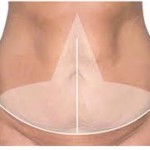While a tummy tuck treats excessive lower abdominal skin and fat, the massive weight loss patient presents more of a challenge. The amount of loose skin almost always goes beyond the traditional horizontally-oriented elliptical excision abdominal pattern. Liposuction has little value in these patients because their contour problems are almost exclusively loose skin. Most of the bariatric patients have skin excesses that involves all three dimensions of the abdomen, including extending into the back. The amount of overall skin creates excessive abdominal girth.
For the bariatric patient an extended abdominoplasty approach is often used that wraps completely around the waistline. Known historically as the belt lipectomy and today as a lower body lift, removing tissue that goes beyond the hips is needed to prevent large dogears and redundant mounds of residual skin in the flanks. But this cutout pattern does not account for the one dimension of extra skin that massive weight loss patients have…the area above the belly button. While pulling this area down with a tummy tuck will help, there will still be substantial loose skin above the final horizontal incision line.

The fleur-de-lis pattern certainly increases the abdominal scar burden in the most noticeable way…right down the center of the abdomen. In the early days of bariatric surgery when gastric by pass was done through an open approach, the existing scar made this consideration a non-issue. Today most bypasses are done laparoscopically so no such scar exists. Patients have to consider this scar trade-off relative to how much upper abdominal loose skin they have. Most bariatric patients consider that a good trade-off once they realize that the upper abdominal area will not be as tight as they would like. Older patients will almost always choose the fleur-de-lis while younger patients are understandably more cautious and conscious about it.
One additional advantage of the fleur-de-lis abdominoplasty is that it provides wide exposure for the repair of hernias. Such hernias are not rare even in the laparoscopically-assisted gastric bypass patient. Estimates are that up to 10% of bariatric patients will develop one or more abdominal hernias.

Because of the extent of surgery in the fleur-de-lis abdominoplasty and the time required to do it, this is often done as a stand alone procedure. This is particularly so if the horizontal excision wraps around the waistline circumferentially.
Dr. Barry Eppley
Indianapolis, Indiana


